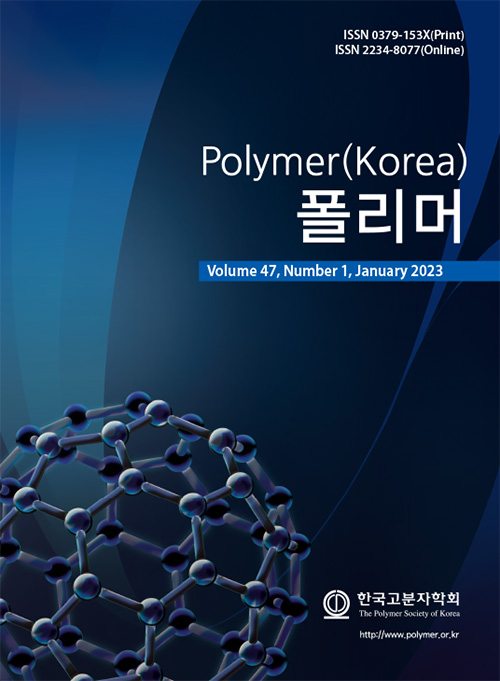- Improving the Properties of PPS/PSU Blends Using High Intensity Ultrasound
Central Technology R&D Institute, Hyundai Oilbank Co., Ltd, 17-10 Mabuk-ro 240beon-gil, Giheung-gu, Yongin-si, Gyeonggi-do 16891, Korea
*Division of Chemical Engineering, Dankook University, 152, Jukjeon-ro, Suji-gu, Yongin-si, Gyeonggi-do 16890, Korea- 고강도 초음파를 이용한 PPS/PSU 블렌드의 물성개선
현대오일뱅크, *단국대학교 화학공학과
Reproduction, stored in a retrieval system, or transmitted in any form of any part of this publication is permitted only by written permission from the Polymer Society of Korea.
The effect of ultrasound on the blend of polyphenylene sulfide(PPS) and polysulfone(PSU) was investigated. The PPS/PSU blends were prepared using a melt mixer equipped with an ultrasonic device, and the thermal and mechanical properties and the morphology were investigated using differential scanning calorimeter, thermal gravimetric analyzer, universal testing machine, and scanning electron microscope. The properties of the sonicated blends were changed according to the sonication time. The thermal properties and mechanical strengths distinctly increased even when the ultrasonic wave was irradiated only for 60 seconds. This increase is thought to be due to the improved interfacial adhesion between the phases of the PPS/PSU blends by the copolymer generated during sonication.
Polyphenylene sulfide(PPS)와 polysulfone(PSU)의 블렌드에 미치는 초음파의 영향을 조사하였다. 초음파 가진 장치가 장착된 용융 혼련기를 이용하여 PPS/PSU 블렌드를 준비하였고 열적, 기계적 물성 및 미세구조를 시차주사열량계, 열중량분석기, 만능시험기, 주사전자현미경을 이용하여 살펴보았다. 초음파를 가진한 블렌드의 물성은 초음파 가진 시간에 따라 변하였는데 초음파를 60초간 가진 했을 때 열적특성과 기계적 강도의 뚜렷한 증가를 보였다. 이는 초음파로 인해 생성된 공중합체가 PPS/PSU 블렌드 내의 상들 사이의 계면 접착력을 향상시켰기 때문이라고 판단되었다.
Keywords: polyphenylene sulfide, polysulfone, ultrasound, in-situ compatibilization.
- Polymer(Korea) 폴리머
- Frequency : Bimonthly(odd)
ISSN 0379-153X(Print)
ISSN 2234-8077(Online)
Abbr. Polym. Korea - 2022 Impact Factor : 0.4
- Indexed in SCIE
 This Article
This Article
-
2023; 47(1): 42-48
Published online Jan 25, 2023
- 10.7317/pk.2023.47.1.42
- Received on Aug 24, 2022
- Revised on Oct 24, 2022
- Accepted on Nov 14, 2022
 Correspondence to
Correspondence to
- Sangmook Lee
-
Division of Chemical Engineering, Dankook University, 152, Jukjeon-ro, Suji-gu, Yongin-si, Gyeonggi-do 16890, Korea
- E-mail: s_mlee@naver.com










 Copyright(c) The Polymer Society of Korea. All right reserved.
Copyright(c) The Polymer Society of Korea. All right reserved.